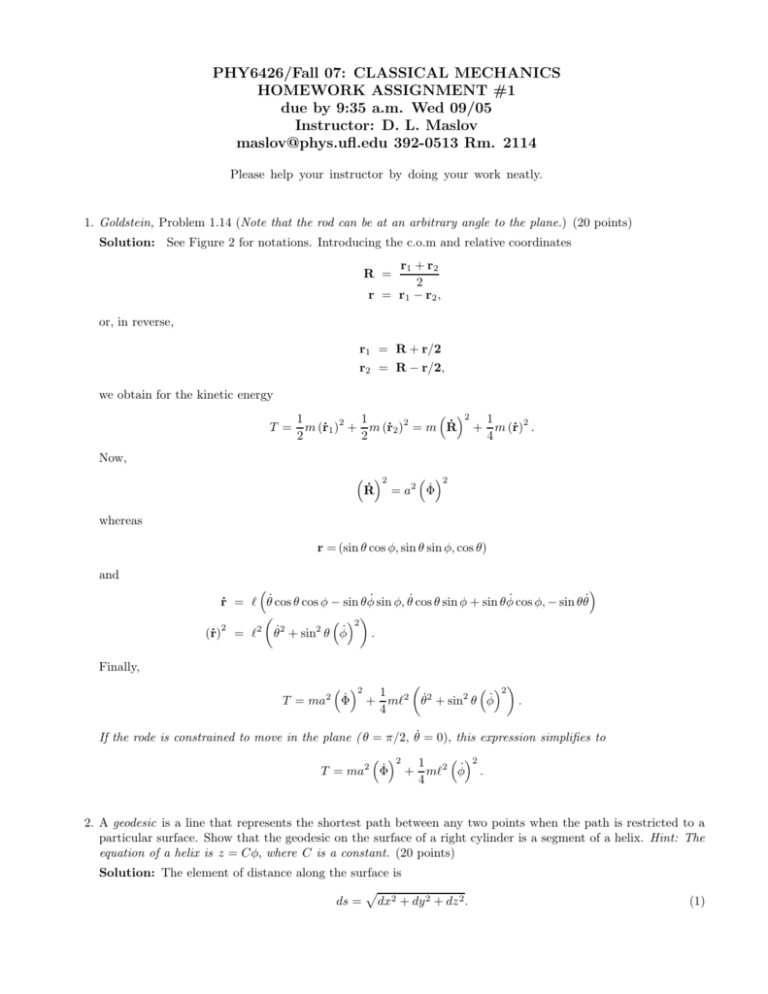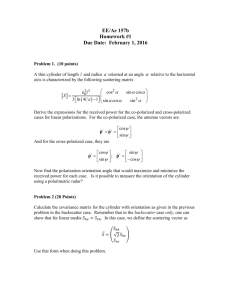PHY6426/Fall 07: CLASSICAL MECHANICS HOMEWORK
advertisement

PHY6426/Fall 07: CLASSICAL MECHANICS HOMEWORK ASSIGNMENT #1 due by 9:35 a.m. Wed 09/05 Instructor: D. L. Maslov maslov@phys.ufl.edu 392-0513 Rm. 2114 Please help your instructor by doing your work neatly. 1. Goldstein, Problem 1.14 (Note that the rod can be at an arbitrary angle to the plane.) (20 points) Solution: See Figure 2 for notations. Introducing the c.o.m and relative coordinates r1 + r 2 2 r = r 1 − r2 , R = or, in reverse, r1 = R + r/2 r2 = R − r/2, we obtain for the kinetic energy T = Now, 2 1 1 1 2 2 2 m (ṙ1 ) + m (ṙ2 ) = m Ṙ + m (ṙ) . 2 2 4 2 2 Ṙ = a2 Φ̇ whereas r = (sin θ cos φ, sin θ sin φ, cos θ) and ṙ = ` θ̇ cos θ cos φ − sin θ φ̇ sin φ, θ̇ cos θ sin φ + sin θ φ̇ cos φ, − sin θθ̇ 2 (ṙ)2 = `2 θ̇2 + sin2 θ φ̇ . Finally, 2 2 1 2 2 2 . T = ma Φ̇ + m` θ̇ + sin θ φ̇ 4 2 If the rode is constrained to move in the plane ( θ = π/2, θ̇ = 0), this expression simplifies to 2 2 1 T = ma2 Φ̇ + m`2 φ̇ . 4 2. A geodesic is a line that represents the shortest path between any two points when the path is restricted to a particular surface. Show that the geodesic on the surface of a right cylinder is a segment of a helix. Hint: The equation of a helix is z = Cφ, where C is a constant. (20 points) Solution: The element of distance along the surface is p ds = dx2 + dy 2 + dz 2 . (1) 2 Φ θ φ FIG. 1: In cylindrical coordinates, x = ρ cos φ, y = ρ sin φ, z = z from which dx = −ρ sin φdφ dy = ρ cos φdφ (2) dz = dz. Substituting (2) into (1) and integrating along the entire path between points 1 and 2, we find s= Z 2 1 Z p 2 2 2 ρ dφ + dz = where ż = dz/dφ. If s is to be minimum, the function f = φ2 dφ φ1 p p ρ2 + ż 2 must satisfy the Euler equation ∂f d ∂f = = 0, dφ ∂ ż ∂z because ∂f ∂z = 0. Thus or d ż 2 d ∂f p = =0 dφ ∂ ż dφ ρ2 + ż 2 ż 2 Solving for ż, we find p ρ2 + ż 2 ż = = C=constant r C2 ρ. 1 − C2 Since ρ is a constant, it means that z = Aφ, where A is a constant. This is the equation for a helix. ρ2 + ż 2 , 3 3. Goldstein, Problem 1.22 (20 points) Solution: x1 = `1 sin φ1 y1 = `1 cos φ1 x2 = `1 sin φ1 + `2 sin φ2 y2 = `1 cos φ1 + `2 cos φ2 i 1 h 2 1 2 2 m1 (ẋ1 ) + (ẏ1 ) = m1 `21 φ̇1 2 2 = −m1 g`1 sin φ1 T1 = U1 2 h i 1 2 1 2 2 m2 (ẋ2 ) + (ẏ2 ) = m2 `21 φ̇1 + `22 φ̇2 + 2`1 `2 φ̇1 φ̇2 cos (φ1 − φ2 ) 2 2 = −m2 g`2 sin φ2 T2 = U2 L = T 1 + T2 − U 1 − U 2 m1 + m2 2 2 m2 2 2 = `1 φ̇1 + ` φ̇2 + m2 `1 `2 φ̇1 φ̇2 cos (φ1 − φ2 ) 2 2 2 + (m1 + m2 ) g`1 cos φ1 + m2 g`2 cos φ2 . Equations of motion h i (m1 + m2 ) `1 φ̈1 + m2 `2 φ̈2 cos (φ1 − φ2 ) − φ̇2 φ̇1 − φ̇2 sin (φ1 − φ2 ) + m2 `2 φ̇1 φ̇2 sin (φ1 − φ2 ) + (m1 + m2 ) g sin φ1 = 0 → 2 (m1 + m2 ) `1 φ̈1 + m2 `2 φ̈2 cos (φ1 − φ2 ) + φ̇2 sin (φ1 − φ2 ) + (m1 + m2 ) g sin φ1 = 0 and h i m2 `22 φ̈2 + m2 `1 `2 φ̈1 cos (φ1 − φ2 ) − φ̇1 φ̇1 − φ̇2 sin (φ1 − φ2 ) − m`1 `2 φ̇1 φ̇2 sin (φ1 − φ2 ) + m2 g`2 sin φ2 = 0 → 2 `2 φ̈2 + `1 [φ̈1 cos (φ1 − φ2 ) − φ̇1 sin(φ1 − φ2 )] + g sin φ2 = 0 1. Linearizing the exact equations of motion for a double plane pendulum, obtained in the previous problem, find the characteristic frequencies of small oscillations. (20 points) olution: Approximating sin φ ≈ φ and cos φ ≈ 1 in Eqs.(??,??), we obtain (m1 + m2 ) `1 φ̈1 + m2 `2 φ̈2 + (m1 + m2 ) gφ1 = 0 `2 φ̈2 + `1 φ̈1 + gφ2 = 0 Substituting φ1 = A1 eiωt φ2 = A2 eiωt , we obtain a characteristic equation A1 (m1 + m2 ) g − ω 2 `1 − m2 `2 ω 2 A2 = 0 −A1 `1 ω 2 + A2 m2 g − `2 ω 2 = 0 4 φ 1 φ 2 FIG. 2: The condition that the determinant is equal to zero yields s q g 2 ω= (m1 + m2 ) (`1 + `2 ) ± (m1 + m2 ) [(m1 + m2 ) (`1 + `2 ) − 4m1 `1 `2 ] . 2m1 `1 `2 2. a) Goldstein, Problem 2.14. (15 points) Variational solution: Notations: distance to the center of mass of the hoop is ρ, the angular position of the c.o.m. os θ, and the angular position of a point on the rim is φ. Lagrangian 2 1 2 1 1 2 L = m (ρ̇) + mρ2 θ̇ + mr2 φ̇ − mgρ cos θ 2 2 2 Constraints: ρ = r+R ρθ = rφ (3) (4) The second constraint is the “no-slipping” condition ρθ̇ = rφ̇, integrated over time. Indeed, a general condition of a “no-slipping” contact of two bodies is that the velocities at the contact point are the same. When one of the bodies is stationary (cylinder), this implies that the contact point is stationary as well. The velocity of the contact point is the sum of the velocity of the center of mass and the linear velocity of the rim. At the contact point, these two velocities are anti-parallel, hence 0 = vc.m. − rφ̇. On the other hand, vc.m. = ρθ̇. Hence, ρθ̇ = rφ̇, and Eq.(4). Correspondingly, there are two constraint functions f1 = ρ − r − R f2 = ρθ − rφ Since neither of the constraints functions depends on the velocities, only the spatial derivatives ∂f α /∂qj appear. Lagrange’s equations ∂f1 ∂f2 d ∂L ∂L − = λ1 + λ2 = λ1 + λ2 θ dt ∂ ρ̇ ∂ρ ∂ρ ∂ρ 5 d ∂L ∂L ∂f2 ∂f2 − = λ1 + λ2 = λ1 ρ dt ∂ θ̇ ∂θ ∂θ ∂θ ∂f2 d ∂L ∂L − = λ2 = −λ2 r dt ∂ φ̇ ∂φ ∂φ or 2 mρ̈ − mρ θ̇ + mg cos θ = λ1 + λ2 θ d 2 mρ θ̇ − mgρ sin θ = λ2 ρ dt mr2 φ̈ = −rλ2 (5) (6) (7) Differentiating Eqs.(3) and (4) over time, we find ρ̇ = ρ̈ = 0 (8) ρθ̈ = rφ̈. Eq.(7) then gives 2 −mρ θ̇ + mg cos θ = λ1 + λ2 θ ρθ̈ − g sin θ = λ2 /m mρθ̈ = −λ2 (9) (10) (11) Substuting λ2 from the last equation into (??), we find that g sin θ. 2ρ θ̈ = Recalling that θ̈ = 1 d 2 θ̇ 2 dθ and integrating the resulting equation with the initial conditions θ (t = 0) = 0 and θ̇ (t = 0) = 0, we obtain θ̇2 = g (1 − cos θ) . ρ Substuting this into Eq.(9) 2mg cos θ − mg = λ1 + λ2 θ The physical meaning of λ1 + λ2 θ is the normal force. The hoop looses contact with the cylinder, when λ1 + λ2 θ = 0 or when cos θ = 1 → θ = 60◦ . 2 b) Repeat Problem 2.14 for an object with inertia I rolling down the cylinder. In which limit does the answer reduce to the case of a point mass sliding down the cylinder? (5 points) SolutionThe variational solution can be carried out in the same way. Just to do things differently this time, I will solve this problem using energy conservation and 2nd Law. Once the constraint v c.m. = ωr , where ω is the angular velocity of rolling, is resolved, the kinetic energy can be written as for an object with inertia I T = 1 1 1 1 v2 2 2 mvc.m. + Iω 2 = mvc.m. + I c.m. . 2 2 2 2 r2 The kinetic energy is equal to the change in the potential energy ∆U = mgρ(1 − cos θ) 6 and 1 1 v2 2 + I c.m. mvc.m. = mgρ(1 − cos θ). 2 2 r2 Second law for the center of mass of the hoop says 2 mvc.m. = mg cos θ − N, ρ where N is the normal force. Condition N = 0, when the hoop loses the contact with the cylinder, correspond to 2 mvc.m. = mg cos θ, ρ or 1 1 mv 2 = mgρ cos θ. 2 c.m. 2 Substituting the last relation into the energy conservation, we find 1 mgρ cos θ(1 + I/mr 2 ) = mgρ(1 − cos θ) → 2 2 cos θ = . 3 + I/mr2 For a hoop, I = mr 2 and cos θ = 1/2. The limit I → 0 correspond to a non-rolling object. In this case we recover cos θ = 2/3








